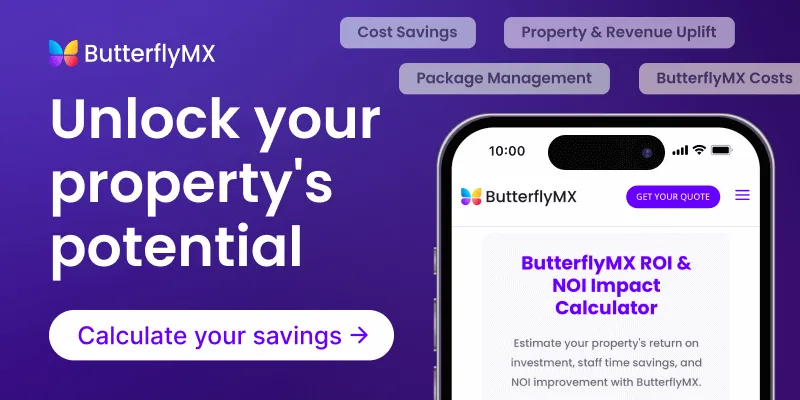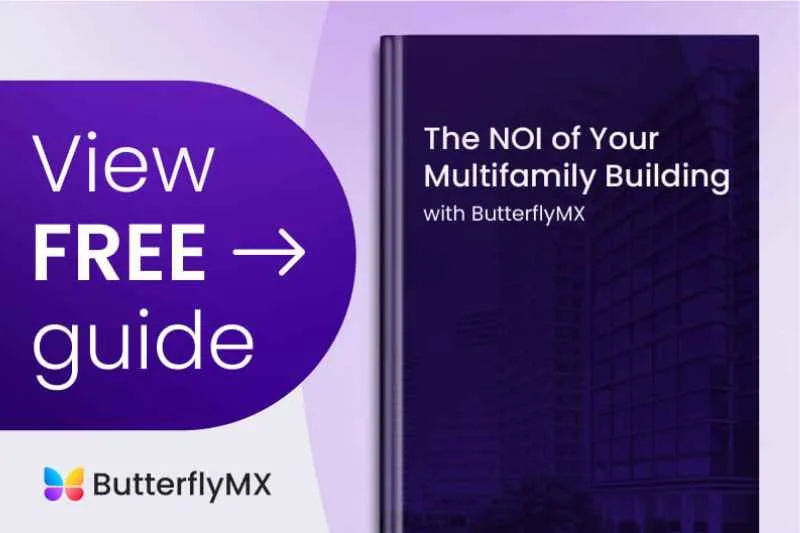Key takeaways
- NOI stands for Net Operating Income and is a calculation used to determine the value and profitability of an income-generating property.
- NOI is used to determine a property’s profitability. To get this answer, you must subtract the operating expenses of a property from the profits generated by a property. Thus, generating more revenue with less expenses results a higher NOI.
- NOI = gross operating income – operating expenses.
- Three ways to maximize your NOI include minimizing operating expenses, increasing rental income, and charging fees for amenities and services.

As a real estate professional, you’ve probably heard the term NOI (net operating income) being tossed around a lot in conversations. And if you’ve been in this industry for long, you know how much real estate NOI matters when it comes to investing in or managing properties. But what is NOI, and why does it matter?
Read on to better understand NOI, why it’s such an important real estate metric, and how to maximize it. In addition, we’ll discuss why investing in property technology (proptech) is one of the best ways to increase your property’s NOI.
This post covers:
- What is NOI in real estate?
- How do you calculate net operating income in real estate?
- Why real estate NOI is so important
- Ways to maximize your real estate NOI
- How proptech affects NOI
What is NOI in real estate?
NOI in real estate, or net operating income, is a valuation method real estate professionals use to determine the profitability of an income-generating property. In general, real estate NOI is calculated by subtracting the property’s operating expenses from the income it produces.
NOI = Gross operating income – operating expenses
Gross operating income includes revenue from:
- Rent
- Parking fees
- Amenity fees and reservations
- Vending machines
- Laundry facilities
While property expenses can vary according to the building’s type, age, and size, all properties have ongoing costs associated with running and maintaining them. They may include insurance, utilities, staff salaries, repairs, and other expenses.
Expenses included when calculating NOI:
- Insurance premiums
- Utilities, including building-wide WiFi and cable TV for common spaces
- Property tax
- Janitorial service fees
- Repair costs
However, one-time capital expenditures (CapEx) — money used to maintain or upgrade physical assets — are excluded from the calculation. Examples of CapEx include installing a new HVAC system or replacing the building’s roof.
Does NOI mean profit?
No, NOI does not mean profit. Rather, the primary difference lies in what these measurements represent.
Net operating income represents the property’s revenue after operating expenses are deducted. Conversely, profit is the amount of money remaining after all expenses have been subtracted.
As mentioned earlier, real estate NOI only considers operating costs, whereas profit includes all expenses, from capital expenditures (CapEx) to debt and interest payments.
Is net operating income the same as EBITDA?
No, NOI is not the same as EBITDA. While both are critical for determining a property’s profitability, they represent different information.
Earnings Before Interest, Taxes, Depreciation, and Amortization (EBITDA), as the name implies, ignores some of the expenses in calculating the profitability of a property.
The EBITDA formula is as follows:
EBITDA = Operating income + Depreciation + Amortization
Overall, EBITDA is considered a measure of a property’s potential earnings. However, not everyone agrees that EBITDA is a worthwhile metric to calculate.
How do you calculate net operating income in real estate?
You can calculate net operating income in real estate by subtracting your operating expenses from your property’s revenue.
In other words, follow the real estate NOI formula:
Net Operating Income = real estate revenue – operating expenses
To help apply the formula in real life, let’s go over an example. Imagine the information below is the monthly revenue and expenses of a multifamily property.
In this case, the monthly net operating income of the property is $28,000 ($47,000 – $19,000). Since NOI is usually calculated annually, simply multiply $28,000 by 12 to get the annual NOI of $336,000.
It’s essential to note that your building’s NOI will vary from the example above and will depend on how your property is operated. Additionally, factors such as rental income and maintenance costs can fluctuate throughout the fiscal year.
Does NOI include real estate taxes?
You calculate net operating income before income tax deductions, but NOI does include property taxes. Income tax is deducted from the property’s gross income in a fiscal year. Taxes for real estate buildings cover the cost of land and any permanent fixtures affixed to it.
Learn what NOI is real estate is and how it works:
Why real estate NOI is so important
Real estate NOI is one of the most important factors for both purchasing a property and setting its budget.
Real estate investors also use net operating income to determine the capitalization rate, which provides an estimated return on investment (ROI) for their real estate investment.
As a property owner or manager, positive NOI is your pathway to getting loans approved, attracting real estate investors, or even new buyers. Property owners can control their own NOI by cutting back on costs while accelerating revenues. For example, they can increase revenues by charging higher rental rates. And they reduce operating expenses by implementing property technology.
How to use NOI to determine cap rate
Investors assess a building’s cap rate to quickly assess whether the building has the potential to be profitable. And net operating income is one part of the equation when calculating the cap rate.
Capitalization rates (cap rates) = NOI / the purchase price
Let’s say a multi-tenant property is listed at $1,000,000, and its NOI is $50,000 annually. We can then determine that the property has a cap rate of 5%.
An investor can see that 5% cap rate and choose whether that’s worth it for them. All real estate investors have different risk tolerances and ideal cap rates.
Ways to maximize your real estate NOI
Depending on your specific property, there are numerous ways to increase your NOI.
Here are three ways to improve NOI:

1. Minimize operating expenses
Start maximizing your net operating income by minimizing your multifamily operating expenses (OpEx) wherever possible.
For example, always obtain three to four bids on contractor jobs, such as carpeting and painting, before committing to a single vendor. There’s almost always a less expensive option for nearly every preventive maintenance task or repair, and you’ll find them once you put in the time to do some research.
Additionally, enabling automation wherever possible will ultimately reduce costs. Investing in automation technology, such as visitor management software or electronic access control systems, requires a significant upfront cost. But it’ll start paying for itself after a few months.
Instead of paying for staff to manage guest access, a smart video intercom system can scan guests’ credentials and allow entry for authorized visitors. This also enhances the security of your property.
2. Increase rental income
Small, incremental increases in your rental rates can lead to significant changes in the long run. However, you should have a detailed and strategic plan for implementing rent increases.
An essential aspect of rental rate increases is tenant retention. Remember, recruiting new renters costs more than retaining existing ones. So, you want to give them a reason to renew their leases even when the rent increases.
To retain residents while raising rents, try organizing events that foster a sense of community within the building and demonstrate your appreciation for them. It’s easy to leave an apartment unit or office space, but it’s hard to leave your community.
And, for multifamily apartments, consider how much more likely residents will work from home today than in the past. As such, residents may want to consider moving from a studio to a one-bedroom or from a one-bedroom to a two-bedroom unit. If you notice that the studio or one-bedroom units in your building are more frequently vacant than before, consider converting them into coworking or storage space.
The space-as-a-service trend has skyrocketed since early 2020, and today’s residents want as much space as possible to live and work in the same building. You can even create a new revenue stream by charging a small fee for rented storage space or coworking space usage.
3. Charge fees for amenities and services
In general, commercial and residential renters are most attracted by amenities that offer safety and convenience. And since technology is so advanced today, tenants expect buildings to be automated by technology.
According to the NAA and NMHC, renters are most interested in security-related amenities. Meanwhile, Wealth Management Real Estate says the number one “item on most renters’ wish lists is technology [amenities] focused on convenience.”
Furthermore, renters are willing to pay more for amenities and services that enhance the convenience and simplicity of their daily lives. Modern tenants seek to live and work in a smart, well-connected building equipped with robust technology. So, carefully select proptech solutions that’ll have the greatest impact.
How proptech affects NOI
In today’s increasingly internet-connected world, you can enhance the tenant experience — and in turn, your property’s NOI — with proptech.
Most importantly, proptech simplifies and streamlines building processes for both tenants and staff. For example, with proptech solutions, property staff don’t have to spend long hours manually updating an access control system or inspecting the building’s HVAC system. Instead, they can focus time and energy on finding more significant ways to engage and retain tenants.
And at the end of the day, it’s your staff members and renters who are the essential factors to maximizing your net operating income. Contrary to popular belief, investing in proptech won’t decrease human interactions in your building community. In fact, investing in the right proptech will eliminate unnecessary expenses, free up your staff’s time to attend to renters, and enhance tenants’ quality of life. As a result, all this will increase your property’s NOI and, subsequently, its value.








